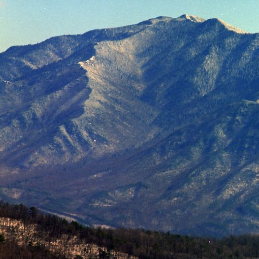Browse
"Optical Measurements of Aerosol Size Distributions in Great Smoky Mountains National Park: Dry Aerosol Characterization." Journal of the Air & Waste Management Association 50, no. 5 (2000): 665-676.
"Our National Parks as Ragweed Hayfever Refuges." Journal of the American Medical Association 138, no. 2 (1948): 126.
"Ozone and PM2.5 Exposure and Acute Pulmonary Health Effects: A Study of Hikers in the Great Smoky Mountains National Park." Environmental Health Perspectives 114, no. 7 (2006): 1044-1052.
"Ozone Injury on Cutleaf Coneflower (Rudbeckia laciniata) and Crown-Beard (Verbesina occidentalis) in Great Smoky Mountains National Park." Environmental Pollution 125, no. 1 (2003): 53-59.
"Patterns in Lightning-caused Fires at Great Smoky Mountains National Park." Fire Ecology 3, no. 2 (2007): 68-82.
"The People of Cades Cove." National Geographic 122, no. 1 (1962): 61-95.
"Peregrine Falcon Growth and Behavior from Nesting to Dispersal Stages at a Smoky Mountain Eyrie." The Migrant 68, no. 4 (1997): 117-122.
"Polymetamorphic Evolution of the Western Blue Ridge: Evidence From AR-40/AR-39 Whole-Rock Slate/Phyllite and Muscovite Ages." American Journal of Science 293, no. 4 (1993): 322-359.
"Polypodium Appalachianum: An Unusual Tree Canopy Epiphyte in the Great Smoky Mountains National Park." American Fern Journal 93, no. 1 (2003): 36-41.
"Population Declines In North American Birds That Migrate to the Neotropics." Proceedings of the National Academy of Sciences of the United States of America 86, no. 19 (1989): 7658-7662.
"Possible Ecological Mechanisms for Loss of Vernal Herb Diversity in Logged Eastern Deciduous Forests." Ecological Applications 5, no. 4 (1995): 935-946.
"Postures Associated with Immobile Woodland Salamanders, Genus Plethodon." Biological Sciences 53, no. 1 (1990): 43-50.
"Predicting Fine-Scale Distributions of Peripheral Aquatic Species in Headwater Streams." Ecology and Evolution 5, no. 1 (2015): 152-163.
"Predicting Future Coexistence in a North American Ant Community." Ecology and Evolution 4, no. 10 (2014): 1804-1819.
"Preliminary Findings From the Great Smoky Mountains National Park Air Quality and Hiker Health Study." Epidemiology 15, no. 4 (2004): S216.
"Prevalence of Leptospira Antibodies in White-Tailed Deer, Cades Cove, Great Smoky Mountains National Park, Tennessee, USA." Journal of Wildlife Diseases 29, no. 4 (1993): 561-567.
"Rarity and Diversity in Forest Ant Assemblages of Great Smoky Mountains National Park." Southeastern Naturalist 6, no. sp2 (2007): 215-228.
"Reconnaissance of Soil-Dwelling Nematodes of Great Smoky Mountains." Journal of Nematology 42, no. 3 (2010): 233-234.
"Reexamining the Role of Lightning in the Landscape." Fire Management Today 66, no. 4 (2006): 25-27.
"The Relation of Rainfall to Elevation in the Southern Appalachian Region." Transactions of the American Geophysical Union 20 (1939): 711-721.
"Reproductive Isolation and Cryptic Introgression in a Sky Island Enclave of Appalachian Birds." Ecology and Evolution (2013).
"The Reptiles and Amphibians of North Carolina." Journal of Elisha Mitchell Scientific Society 77, no. 2 (1961): 125-136.
"Salamander (Pleurognathus marmoratus / Moore) of the Great Smoky Mountains National Park." Journal of the Tennessee Academy of Science 50, no. 2 (1975): 59.
"Scoping a field experiment: error diagnostics of TRMM precipitation radar estimates in complex terrain as a basis for IPHEx2014." Hydrology and Earth System Sciences 19 (2015): 1501-1520.
"Seasonal Development of Ozone-Induced Foliar Injury on Tall Milkweed (Asclepias exaltata) in Great Smoky Mountains National Park." Environmental Pollution 141, no. 1 (2006): 175-183.
















































